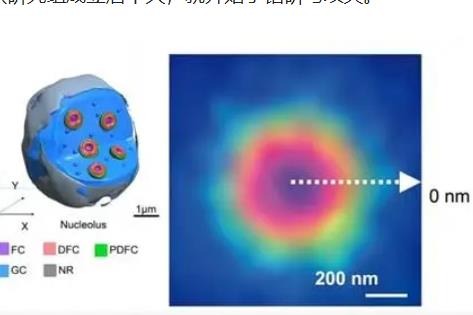Team makes nucleolus research breakthrough
Chinese scientists have made a fundamental breakthrough in the understanding of the nucleolus, a structure with important functions in the nucleus. Their findings may also pave the way for diagnoses and treatments of related diseases.
The nucleolus, a spherical structure with a diameter of 0.5 to 5 microns, is responsible for the production and processing of ribosomal RNA in both humans and animals.
It is widely acknowledged in international medical circles that the excessive production of ribosomal RNA may lead to cancer, and its deficiency may trigger rare diseases, including Diamond-Blackfan anemia; Labrune syndrome, a disease of the nervous system; and Treacher Collins syndrome, which affects the development of the cheeks and jawbone.
A team of researchers from Shanghai's Center for Excellence in Molecular Cell Science at the Chinese Academy of Sciences, studied in detail the location of 200 proteins in the "super factory" of the nucleolus using ultrahigh resolution living cell microscopic imaging technology.
In the past, the nucleolus was thought to be composed of three layers. The fiber center (FC) at its core is surrounded by the dense fiber component (DFC) to form a larger sphere, with multiple FC/DFC units embedded in the same granular component (GC). But the precise location and function of most proteins in the nucleolus as well as how the "super factory" coordinates its complicated structure remained unknown.
In their study, the team led by Chen Lingling found that in addition to the already known three-layer structure, there is an additional layer of spherical shell area wrapping outside the DFC, which they named the PDFC. "We found that newly produced ribosomal RNA in each FC/DFC unit need to pass through PDFC, the "monitoring station", to complete final ribosomal assembly," said Shan Lin, one of the primary authors of the paper.
Further study found that the protein URB1, which is present in the "monitoring station", is key to regulating the folding and processing that occurs at the tail ends of newborn ribosomal RNA.
With their large molecular weight, URB1 proteins act like slow-moving sentinels guarding the PDFC. They provide docking sites for the tail ends of nascent ribosomal RNA transported within each FC/DFC unit, and work with other factors to remove the ends, the researchers said.
"We discovered that ribosomal RNA that have completed end removal are released from the PDFC to the GC area to participate in ribosomal assembly, the work for the next step," said Chen, corresponding author of the study.
"However, once the sentinel disappears, ribosomal RNA swarm into the GC zone with unremoved ends, causing chaos and making the cell unable to operate normally," she said.
In animal experiments, researchers observed that zebra-fish with the protein URB1 suffer malformations of head and face development and do not survive, and that mouse embryos without the protein cannot be implanted in the uterus. Their paper was published in the prestigious science journal Nature on Thursday.
"This report has made remarkable advancements in the knowledge of the relationship between the nucleolar structure and function and its impact on cell biology embryonic development. This will garner the attention of a wide range of readers," a peer review said.

